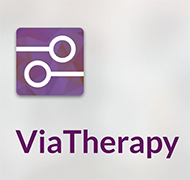13 April 2017
 Stroke is one of the world’s leading causes of disability so a first-of-its-kind app that supports clinicians to develop best practice rehabilitation strategies for patients with arm impairments following stroke is good news for millions of people.
Stroke is one of the world’s leading causes of disability so a first-of-its-kind app that supports clinicians to develop best practice rehabilitation strategies for patients with arm impairments following stroke is good news for millions of people.
The ViaTherapy app, developed through a worldwide collaboration of stroke rehab researchers including UniSA School of Health Sciences Physiotherapy (Rehabilitation) Senior Lecturer, Dr Michelle McDonnell, is the result of a five-year project to make stroke rehabilitation guidelines more accessible to clinicians that was co-led by Dr Mark Bayley from the UHN-Toronto Rehabilitation Institute and Professor Steven Wolf from the Emory University in Atlanta.
“ViaTherapy is a quick and easy decision making tool for occupational therapists and physiotherapists, to help them provide the best therapy approaches for arm rehabilitation with their patients, based on their presentation,” Dr McDonnell says.
“An inbuilt algorithm helps guide therapy choices based on upon best research evidence for the movement the patient has, and the time elapsed since the stroke.
“We have guidelines to follow in Australia but they are very long and cumbersome and this app tailors the interventions to the presentation of the patient, in a way that the current guidelines do not.
“In my teaching of physiotherapy I am also finding the app useful to show my students how they can be confident that the therapy they are providing really is following the best evidence from research around the world.”
Via Therapy app’s internal algorithm considers information inputted by the clinician including how long it has been since the patient’s stroke, how severe their impairment is and whether they have any additional medical conditions.
Medical Director of the Brain and Spinal Cord Rehab Program at Toronto Rehab, Dr Bayley says based on these factors, the app then offers a list of suggestions of which rehabilitation exercises would best promote progress for the patient, such as assessments of certain movements and electrical stimulation for motor recovery.
“Research has shown that because clinicians commit a large portion of their workdays to patient care, they often don’t have the capacity to search the literature for evidence-based therapies, or don’t necessarily have the confidence to evaluate existing research on their own,” Dr Bayley says.
“The right treatment for a patient today may not be the right treatment for them in three weeks so we have tried to capture how a clinician should evolve therapy to involve new treatments depending on how far along the patient is in their recovery.”
The ViaTherapy app provides advice on whether therapy can be delivered in groups or if self-directed treatments are best so that patients can decide which therapy exercises they should do themselves as part of their home practice to enhance the benefits of the traditional stroke rehabilitation they receive.
“I was invited onto this group by Prof Steven Wolf because of my previous work looking at standardising the approach to therapy for people with arm weakness after a stroke,” Dr McDonnell says.
“This app expands this work to look at all areas of therapy that can be provided to for arm rehabilitation post-stroke, including treatment options for those with very little movement.
“It also focuses on regular reassessment of the patient, because we know that recovery can occur at any time, and as soon as we see some return of finger movement then it opens up a wide range of other treatment options to help regain full recovery of the affected arm.”
The ViaTherapy App is available for free on the Apple App Store and the Google Play store for Android devices and at www.viatherapy.org from today.
The development of this app was funded by the Toronto Rehab Foundation and the Canadian Stroke Network. ViaTherapy was created by Pivot Design Group.
Media contact: Katrina McLachlan mobile: 0414972537 email: katrina.mclachlan@unisa.edu.au


